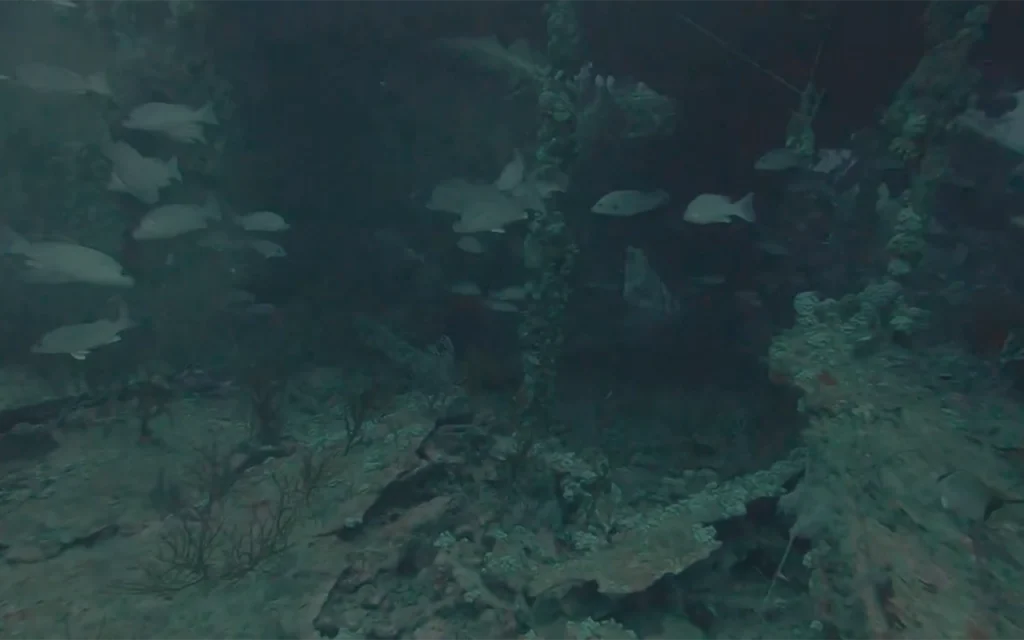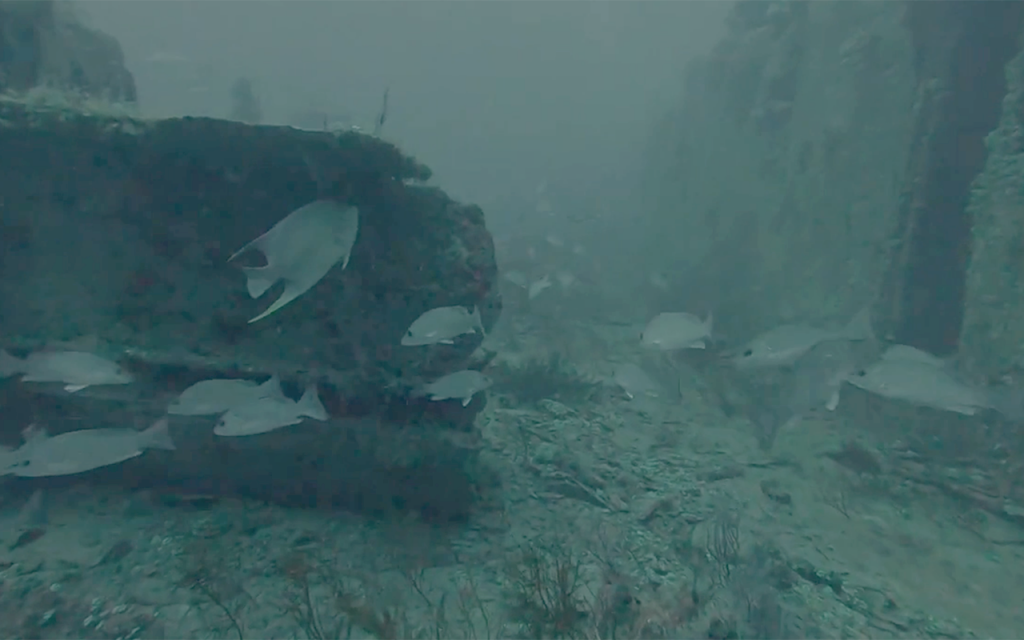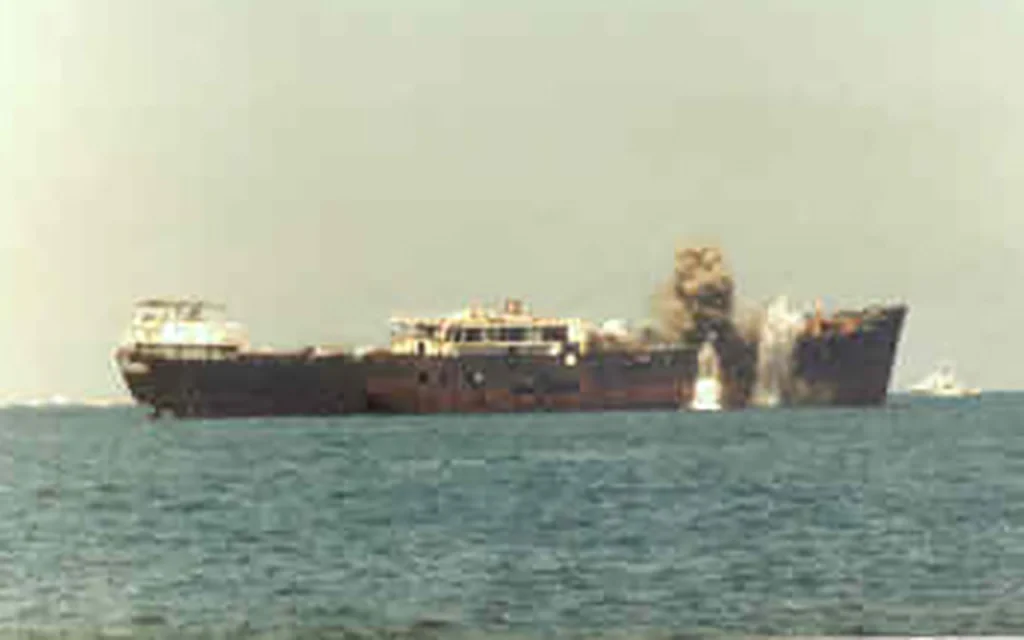Table of Contents

Overall, divers describe the Lowrance as a massive, impressive wreck that offers exciting exploration opportunities for those with the necessary skills and equipment to safely conduct deep, technical dives.
Article at a Glance
- Historical Background: The Lowrance was originally built in 1953 as the refrigerated freighter Ciudad de Cali and underwent several name changes before being sunk as an artificial reef in 1984.
- Dimensions and Location: This massive wreck measures 420 feet in length and 55 feet in width, resting at a depth of 200-210 feet, approximately 2.5 nautical miles off Hillsboro Inlet in Pompano Beach, Florida.
- Diving Experience: The Lowrance is a popular site for technical divers, offering a challenging dive due to its depth and the opportunity to explore its well-preserved engine room and other structural features.
- Marine Ecosystem: The wreck has become an artificial reef, attracting a diverse array of marine life, including large schools of fish, barracuda, and various invertebrates like gorgonians and sponges.
- Unique Features: Divers can explore significant aspects of the wreck, such as the engine room with ambient light filtering through gorgonian-choked skylights and multiple entry points created during its sinking.
- Safety Considerations: Due to its depth, diving the Lowrance requires thorough planning, specialized training, and safety measures such as redundant air supplies and surface support with oxygen and first aid.
- Dive Shops: Several dive shops in Pompano Beach, including Force-E Scuba Centers and South Florida Diving Headquarters, offer trips to the Lowrance, catering to qualified technical divers seeking this unique underwater experience.
Shipwreck Location Coordinates and Depth
Depth
- It sits approximately 2.5 nautical miles outside of Hillsboro Inlet.
- The wreck rests at a depth of approximately 200-210 feet (61-64 meters).
- The main deck of the vessel is found at a depth of 165 feet.
Location Coordinates

What Do Scuba Divers Say About This Ship
Diving Experience
- The Lowrance is considered one of the most popular technical diving sites in South Florida.
- It offers a challenging and rewarding experience for technical divers due to its depth and size.
Key Features
- The wreck provides significant vertical relief, with about 70 feet of structure rising from the seafloor.
- The main deck is found at a depth of 165 feet.
- The midship area is described as particularly interesting.
- Large fish are often spotted as divers descend on the wreck.
Dive Highlights
- For experienced divers, the Lowrance offers a fantastic circuit through the engine room.
- Divers can enter through a hatch on the main deck, leading to a hallway that opens up above the engine room.
- Gorgonian-choked skylights allow ambient light to trickle down onto the catwalks lining the room’s perimeter.
- Multiple exit points are available, including large holes cut during preparation for sinking and smaller holes from explosive charges.
Diving Conditions
- The wreck’s orientation perpendicular to the Gulf Stream current makes it relatively easy to locate, even in strong currents.
- Divers often use a mix of 18/45 (18% oxygen, 45% helium) for these deep dives.
Challenges
- Fishing lines are prevalent on the wreck, posing an entanglement risk. Divers are advised to carry cutting devices.
- The depth (210 feet) requires technical diving training and experience.
What Kind of Marine Life Can Be Found on The Ship
Fish Species
- Large schools of reef fish, including:
- Blue-striped grunts
- Grey snappers
- Porkfish
- Barracuda
- Various species of angelfish
- Parrotfish
- Butterflyfish
Invertebrates and Corals
- Orange cup corals, which often form carpets on structures
- Gorgonians (sea fans), which are mentioned as growing in the skylights above the engine room
- Various species of sponges
Other Marine Life
- Large fish are often spotted as divers descend on the wreck
- Given its depth and structure, the Lowrance likely attracts pelagic species as well
Unique Features
- The engine room offers a particularly interesting habitat, with gorgonian-choked skylights allowing ambient light to filter down
- Multiple decks and openings in the wreck provide numerous habitats for marine life
Key Information
| Category | Details |
|---|---|
| Ship Name | Lowrance |
| Original Name | Ciudad de Cali |
| Year Built | 1953 |
| Builder | Canadian Vickers Limited |
| Dimensions | 420 feet long, 55 feet wide |
| Depth | 200-210 feet (main deck at 165 feet) |
| Location | Approximately 2.5 nautical miles outside of Hillsboro Inlet, Pompano Beach, Florida |
| Sinking Date | March 31, 1984 |
| Current Use | Artificial reef and popular technical diving site |
| Marine Life | Blue-striped grunts, grey snappers, barracuda, angelfish, gorgonians, various sponges |
| Key Features | Engine room, midship area, intact hull, significant vertical relief |
| Diving Type | Technical diving, requires specialized training and equipment |
| Safety Measures | – Thorough dive planning – Redundant air supply – Buddy system – Surface support with oxygen and first aid – Communication systems – Environmental monitoring |
| Dive Shops | 1. Force-E Scuba Centers 2. South Florida Diving Headquarters 3. DH Scuba 4. AquaLife Divers Inc. |
What Makes The Lowrance Shipwreck a Unique Diving Experience
Impressive Size and Depth
- The wreck is massive, measuring 420 feet long and 55 feet wide.
- It sits at a depth of approximately 200-210 feet, with the main deck at 165 feet.
- This combination of size and depth provides a challenging and rewarding experience for technical divers.
Technical Diving Opportunity
- The Lowrance is considered one of the most popular technical diving sites in South Florida.
- Its depth requires specialized training and equipment, making it an attractive target for experienced divers.
- Divers often use a mix of 18/45 (18% oxygen, 45% helium) for these deep dives.
Unique Structural Features
- The wreck offers significant vertical relief, with about 70 feet of structure rising from the seafloor.
- The engine room provides a fascinating circuit for exploration, featuring:
- A hatch entry on the main deck
- A hallway leading to the engine room
- Gorgonian-choked skylights allowing ambient light to filter down
- Catwalks lining the room’s perimeter
Historical Significance
- Built in 1953 as a refrigerated freighter, the ship has a rich history, including multiple name changes and conversions.
- It was intentionally sunk as an artificial reef in 1984, named after the marine electronics company that donated funds for its sinking.
Marine Life
- The wreck attracts large fish, often spotted as divers descend.
- Its structure provides habitat for various marine species, enhancing the diving experience.
Diving Conditions
- The wreck’s orientation perpendicular to the Gulf Stream current makes it relatively easy to locate, even in strong currents.
- This positioning offers unique diving conditions compared to other wrecks in the area.
How Does The Lowrance Compare to Other Shipwrecks in Florida
Depth and Accessibility
- The Lowrance sits at 200-210 feet deep, making it one of the deeper wrecks accessible to divers in Florida.
- Many other popular Florida wrecks, like those in the Keys, are in shallower waters and more accessible to recreational divers.
- The Lowrance’s depth puts it in the technical diving category, unlike many of the shallower wrecks mentioned in the Florida Keys.
Historical Significance
- While the Lowrance is a relatively modern wreck (sunk in 1984), many Florida wrecks date back to the colonial era.
- Shipwrecks like those from the 1733 Spanish fleet in the Keys have greater historical significance, representing Spain’s colonial presence.
- The Lowrance lacks the treasure-hunting allure of older Spanish galleons that carried gold and silver.
Size and Structure
- At 420 feet long, the Lowrance is one of the larger wrecks off Florida’s coast.
- Its intact structure, including the explorable engine room, offers a different experience compared to older wrecks that may be more deteriorated or scattered.
Marine Life
- Like many Florida wrecks, the Lowrance serves as an artificial reef, attracting various marine life.
- However, due to its depth, it may host different species compared to shallower wrecks.
Diving Experience
- The Lowrance offers a challenging, technical dive experience, setting it apart from many of Florida’s more accessible wrecks.
- It caters to a specific subset of experienced divers, unlike some of the shallower wrecks that are popular among recreational divers.
Conservation Status
- As a purposely sunk artificial reef, the Lowrance’s status differs from many accidental shipwrecks that are protected as historical sites.
What is The Full History of This Ship
Original Construction and Early Years
- Built in 1953 by Canadian Vickers Limited at their Montreal shipyard.
- Originally constructed as a refrigerated freighter for the Colombian shipping company Flota Mercante Gran Colombiana SA.
- Initially named “Ciudad de Cali” upon launch in 1953.
Name Changes and Conversions
The ship underwent several name changes and modifications throughout its service:
- Ciudad de Cali (1953-1972)
- Rio Amazonas (1972-1980)
- Mazon (1980-1984)
- Lowrance (1984-present)
In 1981, the mid-ship superstructure was razed, and the vessel was converted into a barge.
Final Years and Sinking
- The vessel experienced a mechanical breakdown and became stranded in Port Everglades.
- It remained there for three years until its fate was decided.
- On March 31, 1984, it was intentionally sunk as an artificial reef off the coast of Fort Lauderdale.
- The marine electronics company Lowrance donated funds for the cleanup and sinking process, which is why the wreck bears its current name.
Post-Sinking
- Since its intentional sinking, the Lowrance has become one of the most popular technical diving sites in South Florida.
- It sits approximately 2.5 nautical miles outside of Hillsboro Inlet.
- The wreck rests at a depth of about 200-210 feet (61-64 meters), with the main deck at 165 feet.
- Its position perpendicular to the Gulf Stream makes it relatively easy for divers to locate, even in strong currents.

What Historical Features Can Still Be Identified on The Lowrance Wreck
Engine Room
- The engine room remains a key feature of the wreck, offering a fascinating circuit for exploration.
- It can be accessed through a hatch on the main deck, leading down a hallway.
- The room features catwalks lining its perimeter.
- Gorgonian-choked skylights allow ambient light to filter down into the space.
Deck Structures
- The main deck is found at a depth of 165 feet.
- While some upper decks have experienced significant collapse in recent years, portions of the deck structure remain.
Hull
- The wreck provides significant vertical relief, with about 70 feet of structure rising from the seafloor.
- The hull sits upright on the ocean floor at 210 feet depth.
Entry/Exit Points
- Large holes cut during preparation for sinking can be found, likely on the hull.
- Smaller holes produced by explosive charges used to sink the ship are also present.
Midship Area
- This section is described as particularly interesting, though specific details are not provided.
Overall Structure
- At 420 feet long and 55 feet wide, the massive size of the freighter is still evident.
- The bow points to the south.
What Safety Measures Are in Place for Divers Visiting the Lowrance
Dive Planning and Preparation
- Thorough dive planning is essential due to the wreck’s depth (200-210 feet) and technical nature.
- Divers are likely required to have appropriate technical diving certifications and experience.
- Use of trimix gas blends (like 18/45) is common for these depths to mitigate narcosis risks.
Equipment Requirements
- Redundant air supply systems are likely mandatory (e.g. twin tanks or rebreathers).
- Dive computers capable of handling technical dive profiles are necessary.
- Cutting devices are recommended to deal with potential entanglement in fishing lines.
Dive Procedures
- Strict adherence to planned depth, time, and decompression limits is crucial.
- Buddy system is likely enforced, with frequent buddy checks during the dive.
- Use of guidelines or reels may be required for navigation, especially if penetrating the wreck.
Surface Support
- Dive boats likely have oxygen and first aid equipment on board.
- Communication systems between divers and the surface (e.g. surface marker buoys) are probably required.
- Decompression stations or extra tanks may be set up at shallower depths for safety stops.
Wreck-Specific Precautions
- Divers are likely briefed on the wreck’s layout, including potential hazards and exit points.
- Penetration into the wreck may be restricted to properly trained and equipped divers.
- Guidelines about not disturbing the wreck or marine life are typically in place.
Environmental Considerations
- Dive planning takes into account the Gulf Stream current, which can be strong in the area.
- Weather and sea conditions are closely monitored, with dives potentially canceled in adverse conditions.
Dive Shops That Provide Diving Trips to This Shipwreck
- Force-E Scuba Centers – Pompano Beach
- Address: 1312 N Federal Hwy, Pompano Beach, FL 33062
- Phone: (954) 943-3483
- Website: https://www.force-e.com/dive-shops/pompano-beach/
- South Florida Diving Headquarters
- Address: 101 N Riverside Dr # 111, Pompano Beach, FL 33062
- Phone: (954) 783-2299
- Website: http://www.southfloridadiving.com/
- DH Scuba
- Address: 840 SE 22nd Ave, Pompano Beach, FL 33062
- Phone: (954) 294-5600
- Website: https://www.dhscuba.com/
Central Florida Wrecks
- SS Breconshire
- Georges Valentine
- Hog Heaven
- Urca De Lima
- USS Rankin
- Ana Cecilia
- United Caribbean
- USS Mindanao
- The Laertes
- Berry Patch Tug Wreck
- The Liberty Ship
- The Ana Cecilia
- The Cities Service Empire
- USS Accokeek
- The Tortuga Wreck
- Princess Ann Wreck (Palm Beach)
- Okinawa Wreck (Pompano Beach)
- MG-111 Wreck (Jupiter)
- Lady Luck Wreck (Pompano Beach)
- Rodeo 25 Wreck (Pompano Beach)
- Lowrance Wreck (Pompano Beach)
- RSB-1 Wreck (Deerfield Beach)
- Rebel Wreck (Deerfield Beach)
- Noulla Express Wreck (Fort Lauderdale)
- Sucre Wreck (Fort Lauderdale)
- Captain Tony Wreck (Pompano Beach)
- Peter McAllister Wreck (Pompano Beach)
- Guy Harvey Wreck (Fort Lauderdale)
- Quallman Tugs Wreck (Pompano Beach)
- Miller Lite Wreck (Pompano Beach)





